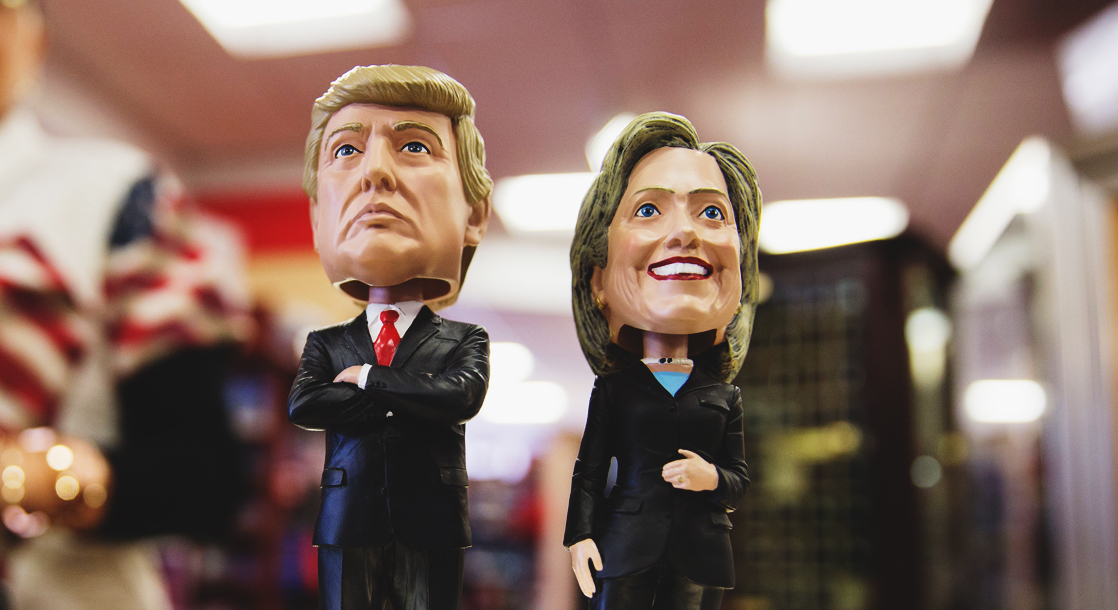As the American electorate becomes ever more polarized, the shares of the vote that are truly up for grabs becomes smaller and smaller. As a result, the dwindling shares of the electorate that are truly persuadable – as in, voters who truly have not made up their minds about their preferred candidate – become exponentially more valuable.
This phenomenon has become particularly acute in the past several weeks, as polling shows presumptive Democratic nominee Hillary Clinton losing some ground in her quest to defeat presumptive GOP nominee Donald Trump. (How much she’s lost is up for debate.) As such, every little bit counts.
Enter the parties’ nominating conventions. The conventions – with their opportunities to present a united party front and a positive vision of the future for both the party and the country – are usually followed by a bump in the polling numbers of each party’s nominee. This is known as a “convention bounce”, which often dissipates in the weeks or months after.
Two of the best examples in recent electoral history have been George H. W. Bush in 1988 and Bill Clinton in 1992, both of whom had been lagging behind their opponents ahead of the conventions and received huge convention bumps, which culminated in both of them winning the election in their respective years.
So should we expect any convention bumps in 2016? There are several conceivable scenarios that could play out.
The first is that Hillary Clinton receives a sizable convention bump while Donald Trump receives little to none. After only recently vanquishing her opponent during the primaries, Sen. Bernie Sanders (N.H.), Hillary Clinton has some work to do in uniting her party: A recent poll found that only 55 percent of Bernie Sanders voters say they will vote for the former secretary of state; 40 percent say they will vote for another candidate.
And yet, there is reason to believe that those voters not currently supporting the Democratic standard-bearer will ultimately come home. With the parties so polarized, it remains unlikely that the supporters of a party’s nominee will cross over to vote for the opposing party’s nominee, regardless of they sound and fury they emit between the primaries and the November election.
“Politics is a rich broth of personal self-interest, ideology and tribal loyalty,” political reporter Megan McArdle recently wrote. “For all of these reasons, most of the folks who voted for Sanders in primaries will want to see their team win in November, even if they think their favorite player has been unjustly benched. Every four years, people claim to see no difference between the center-right and center-left candidates that our system routinely nominates, and every four years, when Election Day rolls around, they contemplate the prospect of the other team winning and decide that maybe there is some small difference after all.”
A successful Democratic convention could bring those Democratic voters back into the fold, resulting in a real bump for Clinton.
Trump, on the other hand, does not enjoy the same floor of support among GOP voters; instead, he appears to have reached a ceiling. Trump’s numbers have had something of a rebound in the days since FBI Director James Comey lambasted Clinton’s use of a private email server during her time as Secretary of State; however, recent polling suggests Trump has not been able to manage anything more than a tie with Clinton, and has not been able to break past 40% in the battleground states.
“These polls — which mostly show Clinton either ahead or tied in these battlegrounds — were all taken during or after Clinton’s roughest week of the general election, with FBI Director James Comey’s rebuke over her emails,” NBC News recently wrote. “So you could view these battleground numbers as a floor for Clinton, while Trump is still unable to break 40% in many of these states.”
Then again, it is easy to see neither candidate gaining much after the convention. According to a recent CBS News/New York Times poll, “90 percent of Trump voters and 88 percent of Clinton voters say their choice is set. About one in 10 of each candidate’s supporters say their minds might change before the election.”
A negligible polling bump for either major-party candidate has become something of a trend in the past several election cycles, a phenomenon that may again be attributable to political polarization. “It is possible that partisans are so much more committed to their candidates now than they were before and there is a much smaller persuadable electorate that can be influenced by events like the nominating conventions,” writes political scientists Thomas M. Holbrook.
To sum up: there are a number of different polling-related possibilities for the candidates coming out of the conventions, though these days a small bump is more likely than a large one. Let the conventions begin!











